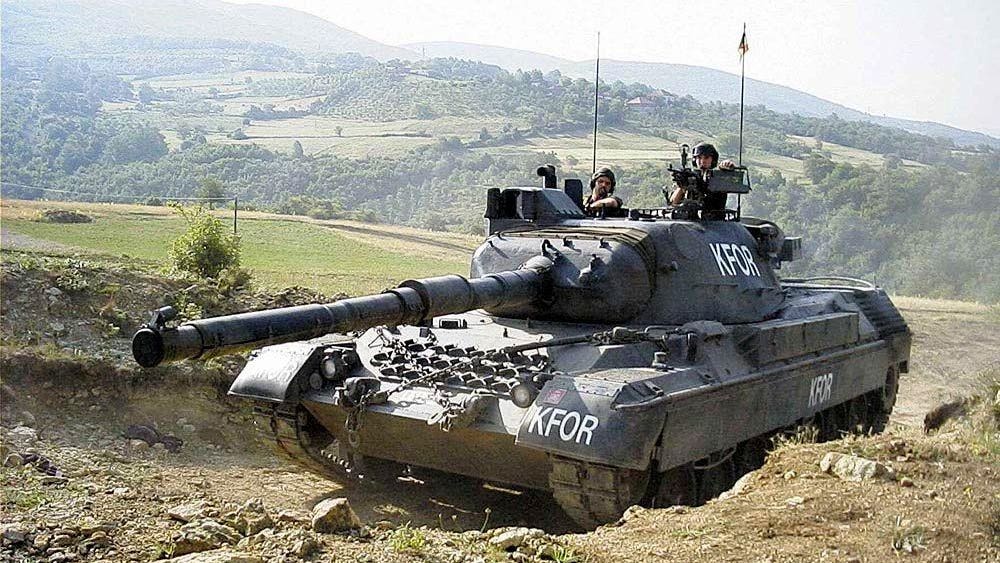The Ukrainian armed forces are about to get a lot of old Leopard 1A5 tanks. As many as 200.
Just how useful the 1980s-vintage, German-designed tanks will be to Ukraine’s war effort depends on how the Ukrainians choose to use them—and how heavily they upgrade the 40-ton, four-person vehicles.
The German government back in February approved the Leopard 1A5 for export to Ukraine. The plan was for Germany and Denmark—both former Leopard 1 operators—to finance, along with The Netherlands and on Ukraine’s behalf, the acquisition and refurbishment of at least 135 Leopard 1A5s.
Training of Ukrainian crews began this spring in Germany. And in late July, the first 10 Leopard 1A5s arrived in Ukraine.
Those first tanks might be destined for the Ukrainian army’s new 44th Mechanized Brigade. The balance of the initial consignment of at least 135 Leopard 1A5s could equip as many as four battalions—one each for four mechanized brigades. Every subsequent batch of 30 tanks could form a battalion.
While the German-Danish-Dutch consortium was working on the first big batch of Leopard 1A5s, the Belgian government was working up its own Leopard 1 consignment.
That deal took a while: it wasn’t until this week that Rheinmetall, the German firm that built the Leopard 1, announced it would refurbish for Ukraine an additional 30 Leopard 1s from a batch of 50 that previously belonged to Belgian company OIP Land Systems.
That should bring to at least 165 the number of Leopard 1s bound for Ukraine—a number that could continue to grow as European governments locate and acquire additional stocks of the old tanks. Marcus Faber, a member of the German Defense Committee, claimed Ukraine would get a hundred Leopard 1s in 2023 and another hundred in 2024.
It won’t be long before the Leopard 1A5 is Ukraine’s most numerous Western-made tank. Kyiv’s forces have received, or soon should receive, 54 Leopard 2A4s, 10 Leopard 2A5s—actually, Swedish versions of that type—plus 21 Leopard 2A6s. They’ve also gotten 14 British Challenger 2s; 31 American M-1A1s are en route.
The Leopard 2s have been in intensive combat at the bleeding edge of Ukraine’s 2023 counteroffensive, which kicked off on June 4. The Russians have destroyed two Leopard 2A4s and two Leopard 2A6s and damaged several of each model; some battle-scarred A4s already are in Poland for repairs.
Despite these losses, Ukraine’s European allies have not pledged more Leopard 2s—likely because their own armies still use the 60-ton tanks. And any inactive Leopard 2s in storage—say, in Spain—are in extremely poor condition.
The United Kingdom likewise hasn’t offered up more Challenger 2s, perhaps because the British Army already has too few of the 70-ton tanks and wants to upgrade them for its own use.
Barring construction of new tanks on a hot production line, which could take years, the Leopard 1 and American M-1—both of which are comparatively abundant—are likely to become Ukraine’s main Western tanks. Whether the M-1 fleet ever outnumbers the Leopard 1 fleet depends on whether and how quickly the United States pledges additional batches of the 70-ton American tank.
While the M-1 really is a real tank—heavily armed with a powerful 120-millimeter gun and thickly protected with 450 millimeters of steel and tungsten—the much lighter Leopard 1A5 these days is less a tank than it is a mobile gun.
Its 105-millimeter gun is accurate and reasonably powerful, but its armor—just 70 millimeters of steel at its thickest—is woefully inadequate for the kind of fighting that occurs every day in Ukraine. If heavily-armored Leopard 2s are getting knocked out, Leopard 1s don’t stand a chance.
But only if the Ukrainians deploy the Leopard 1s as tanks—placing them at the front of armored columns for direct assaults on Russian fortifications.
If Kyiv’s troops do with their Leopard 1s what they belatedly learned to do with their lightweight, ex-French AMX-10RC reconnaissance vehicles—that is, put them behind the armored infantry, from where they safely can bring their long-range firepower to bear—then the aging Leopards might actually do some good.
Expect the Ukrainians to do everything they can to mitigate the weaknesses of the Leopard 1A5’s design as the tank gradually becomes one of the more common combat vehicles in Ukraine’s arsenal. For starters, look for the Ukrainians to add layers of explosive reactive armor, just like they’ve done with their Leopard 2A4s.
It’s possible the Leopard 1s also are getting unspecified upgrades to their fire-controls. The Leopard 1A5 already boasts a highly-accurate EMES 18 fire-control system paired with precise thermal optics.
But camera technology moves fast, and the EMES 18 is 40 years old. Faber, from the German Defense Committee, said Rheinmetall was fitting Ukraine-bound Leopard 1s with “new sensors, which gives them clear advantages in battle.”
Even a layer of ERA and better sensors can’t make a Leopard 1A5 into a Leopard 2A6 or an M-1A1. No, the Ukrainian military is set to receive a whole lot of tanks that aren’t really tanks.
But as a mobile gun, the Leopard 1A5 could lend significant long-range firepower to an infantry-first assault. “It is better than no tank at all,” Faber pointed out.
Read the full article here





